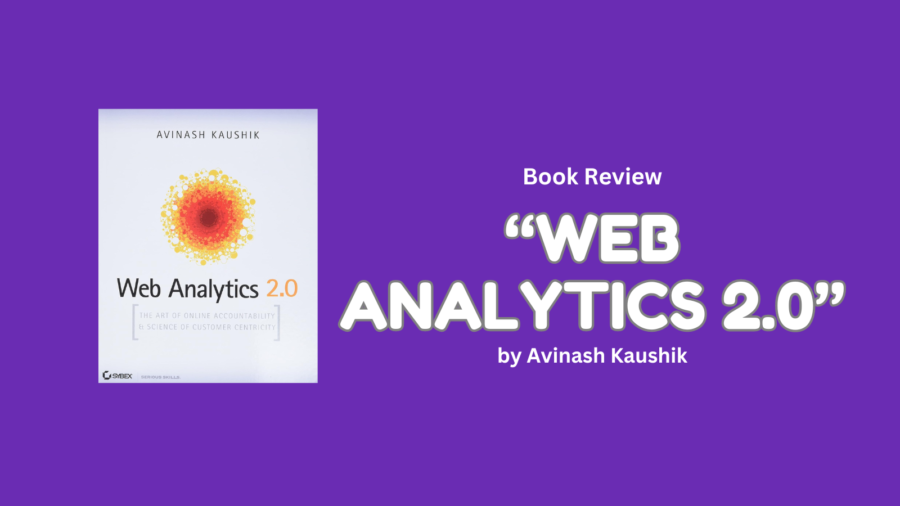“Web Analytics 2.0: The Art of Online Accountability and Science of Customer Centricity” by Avinash Kaushik is a comprehensive guide that transcends conventional notions of web analytics, ushering readers into a realm where data transforms into actionable insights, and customer-centricity becomes the lodestar for online success. As I delve into the pages of this illuminating tome, I am confronted with a paradigm shift from traditional analytics methodologies to a more nuanced and holistic approach.
Kaushik underscores the need for Analytics to evolve beyond quantitative website performance measurements. In the realm of Analytics, it’s not just about numbers; it’s about deciphering the story behind the numbers. Kaushik introduces the “Analytics 2.0” concept, emphasizing a more sophisticated and insightful approach to web data analysis. This paradigm shift involves moving beyond raw metrics and embracing a holistic understanding of user behavior and intent.
The author adeptly weaves a narrative that revolves around the interplay of six key elements of Analytics: Data Capture, Data Reporting, Data Analysis, Testing, Business Impact, and Privacy. This hexad is the backbone of a robust Analytics strategy, wherein each component plays a pivotal role in extracting meaningful insights from the vast sea of online data. By frequently interjecting the term “Analytics” throughout the narrative, Kaushik reinforces the centrality of this discipline in the digital landscape.
Kaushik’s book serves as a beacon for those seeking to navigate the labyrinth of online data, guiding them toward a destination where Analytics is not merely a tool but a mindset. The author meticulously outlines a framework for achieving a customer-centric approach, asserting that successful Analytics is rooted in an unwavering focus on the end-user. Through real-world examples and case studies, he illustrates how businesses can leverage Analytics to comprehend customer behavior, preferences, and pain points.
One of the book’s salient features is its exploration of Analytics as a cyclical process rather than a linear one. Kaushik introduces the concept of the “See, Think, Do, Care” framework, a model that mirrors the customer’s journey through the online sphere. This model resonates with the essence of Analytics, emphasizing its role at every stage of the customer lifecycle. Organizations can create a more holistic and customer-centric digital experience by incorporating Analytics seamlessly into each phase.
As Kaushik articulates, analytics is not a monolithic entity but a multi-faceted discipline. He delves into the intricacies of qualitative and quantitative data, positing that a balanced amalgamation of both is essential for a comprehensive understanding of user behavior. This nuanced approach challenges the conventional dichotomy between numbers and narratives, propelling Analytics into a realm where it is both an art and a science.
Moreover, Kaushik dissects the fallacy of focusing solely on page views and bounce rates. He advocates for a shift towards more meaningful metrics that align with business objectives, such as engagement, conversion, and customer loyalty. This reorientation underscores the transformative power of Analytics in steering organizations away from vanity metrics towards actionable insights that drive tangible business outcomes.
Analytics permeates every facet of the online landscape, and Kaushik’s book meticulously elucidates its role in diverse contexts, from e-commerce to social media. He emphasizes the need for a tailored approach, recognizing that different business models necessitate different Analytics strategies. By weaving together a tapestry of real-world examples, Kaushik illustrates how Analytics can be customized to align with various industries’ unique goals and challenges.
As I traverse the pages, the recurring theme of Analytics as a catalyst for innovation emerges. Kaushik contends that Analytics is not just a retrospective tool but a proactive force that can shape future strategies. Through iterative testing and experimentation, businesses can glean insights that drive continuous improvement. This iterative approach is confined to the digital realm and extends to the broader organizational landscape, fostering a culture of data-driven decision-making.
The book is not without its warnings and admonitions. Kaushik raises a red flag on the perils of data silos, emphasizing the need for a unified and integrated approach to Analytics. Siloed data, he contends, impedes the ability to derive holistic insights and inhibits a comprehensive understanding of customer behavior. This underscores the pivotal role of Analytics in breaking down organizational silos and fostering cross-functional collaboration.
Kaushik underscores the inextricable link between Analytics and business impact. In its truest form, analytics is not an isolated endeavor but a means to an end — the end being informed decision-making and tangible business outcomes. Organizations can transform data into a strategic asset that propels them toward success by aligning Analytics with business goals and measuring its impact on key performance indicators.
The author provides a roadmap for businesses to navigate the intricate terrain of Analytics. He introduces the concept of a “Analytics Center of Excellence,” an organizational structure designed to institutionalize the practice of Analytics. This dedicated hub catalyzes the dissemination of analytics expertise across departments, fostering a culture of data literacy and ensuring that the entire organization is equipped to harness the power of data.
In conclusion, “Web Analytics 2.0” by Avinash Kaushik transcends the realm of a conventional guide, evolving into a manifesto that propounds the transformative power of Analytics. Through a blend of theoretical frameworks, real-world examples, and practical insights, Kaushik demystifies the intricacies of web Analytics, making it accessible to novices while offering profound revelations to seasoned practitioners. By consistently interweaving the term “Analytics” throughout the narrative, he underscores its omnipresence in the digital landscape. This book is not just a guide; it’s a call to action for organizations to embrace Analytics as a cornerstone of their digital strategy, propelling them toward a future where data is not just a resource but a strategic asset.





